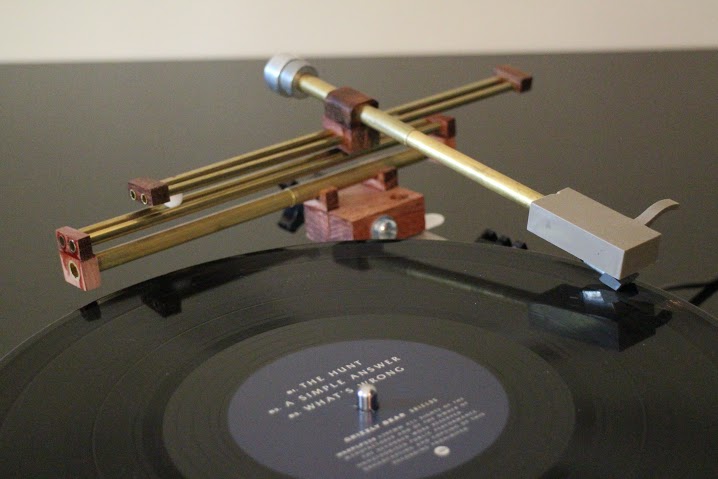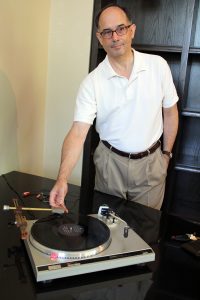A commitment to audio fidelity has landed a Richmond lawyer his first patent and a chance to potentially get a taste of the music business.
Thomas Bowden has patented his own version of a tone arm, the part of a record player that attaches to the needle that plays the vinyl records. The patent was granted by the U.S. Patent and Trademark Office in May.
Bowden’s tone arm design is meant to decrease the distortion-creating friction caused by the contact of the needle with the spinning vinyl. Bowden said his tone arm design makes it so a record player’s needle mimics the movement of the lathe that forms the grooves on records when they’re made. Bowden said doing so creates a sound that is truer to the recording.
“It’s a device that allows the groove of the records to be read in the same way they are created,” Bowden said. “Going back to (Thomas) Edison, there have been devices that attempt to track records the way they were recorded.”
Typically, tone arms pivot as they sit in the grooves of a spinning record. Bowden’s prototyped design keeps the arm rigid at a 90 degree angle as it reads the record, attached to free rolling ball bearings that sit between parallel tracks.
Bowden said most recordings are made first on tape or digital. They eventually get mixed down to a two channel stereo signal that is carved into a master record by a vibrating cutting head.
“By allowing the needle to move in the exact same way as the cutting head moves, you are avoiding a lot of distortion,” Bowden said.
Bowden said he’s long been an audiophile and got serious about minimizing the distortion on his LPs about six or seven years ago. The light bulb moment came when he was using model trains to figure out ways of minimizing friction. He said it all came to together when he put a set of train tracks on top of a set of wheels already moving on another set of tracks.
“It was like ice on ice,” Bowden said.
Bowden said there are tone arms on the market that minimize friction using air compression or computer technology that can cost as much as $20,000.
“They work pretty well,” Bowden said. “But I think they still suffer from some flaws mine has corrected.”
Bowden said his interest in music recordings and the technology that makes them possible date to his high school days. The crackling distortion associated with vinyl piqued his curiosity.
“I’d hear distortion and I’d wonder where it came from,” Bowden said. “It just seemed to be something that maybe I could solve. It was just something my brain wanted to fiddle with I guess.”
Vinyl distortion isn’t the only thing that occupies his mind.
Bowden has his own law practice based at 2501 Monument Ave., and he was previously with Sands Anderson. He was part of a startup formerly called Integrity Communications that created wireless broadband systems. The company eventually sold its technology.
He writes on bike advocacy issues and his work has appeared on Commute By Bike and Richmond BizSense.
Bowden is also an amateur violinist and is learning how to make his first violin under his wife’s tutelage.
“If you love doing things, you find the time,” Bowden said. “This is my first patent and I plan to expand on it. I got as much done as I could in the first pass.”
As for the potential commercial future of his new invention, Bowden said he is considering whether to start a low-volume company modeled after high-end furniture and audio maker Fern and Roby, or license his patent to an existing business.
A commitment to audio fidelity has landed a Richmond lawyer his first patent and a chance to potentially get a taste of the music business.
Thomas Bowden has patented his own version of a tone arm, the part of a record player that attaches to the needle that plays the vinyl records. The patent was granted by the U.S. Patent and Trademark Office in May.
Bowden’s tone arm design is meant to decrease the distortion-creating friction caused by the contact of the needle with the spinning vinyl. Bowden said his tone arm design makes it so a record player’s needle mimics the movement of the lathe that forms the grooves on records when they’re made. Bowden said doing so creates a sound that is truer to the recording.
“It’s a device that allows the groove of the records to be read in the same way they are created,” Bowden said. “Going back to (Thomas) Edison, there have been devices that attempt to track records the way they were recorded.”
Typically, tone arms pivot as they sit in the grooves of a spinning record. Bowden’s prototyped design keeps the arm rigid at a 90 degree angle as it reads the record, attached to free rolling ball bearings that sit between parallel tracks.
Bowden said most recordings are made first on tape or digital. They eventually get mixed down to a two channel stereo signal that is carved into a master record by a vibrating cutting head.
“By allowing the needle to move in the exact same way as the cutting head moves, you are avoiding a lot of distortion,” Bowden said.
Bowden said he’s long been an audiophile and got serious about minimizing the distortion on his LPs about six or seven years ago. The light bulb moment came when he was using model trains to figure out ways of minimizing friction. He said it all came to together when he put a set of train tracks on top of a set of wheels already moving on another set of tracks.
“It was like ice on ice,” Bowden said.
Bowden said there are tone arms on the market that minimize friction using air compression or computer technology that can cost as much as $20,000.
“They work pretty well,” Bowden said. “But I think they still suffer from some flaws mine has corrected.”
Bowden said his interest in music recordings and the technology that makes them possible date to his high school days. The crackling distortion associated with vinyl piqued his curiosity.
“I’d hear distortion and I’d wonder where it came from,” Bowden said. “It just seemed to be something that maybe I could solve. It was just something my brain wanted to fiddle with I guess.”
Vinyl distortion isn’t the only thing that occupies his mind.
Bowden has his own law practice based at 2501 Monument Ave., and he was previously with Sands Anderson. He was part of a startup formerly called Integrity Communications that created wireless broadband systems. The company eventually sold its technology.
He writes on bike advocacy issues and his work has appeared on Commute By Bike and Richmond BizSense.
Bowden is also an amateur violinist and is learning how to make his first violin under his wife’s tutelage.
“If you love doing things, you find the time,” Bowden said. “This is my first patent and I plan to expand on it. I got as much done as I could in the first pass.”
As for the potential commercial future of his new invention, Bowden said he is considering whether to start a low-volume company modeled after high-end furniture and audio maker Fern and Roby, or license his patent to an existing business.


What goes around comes around (pun intended). Tangential tracking tonearms were all the rage in the early/mid 70’s. Garrard, Rabco Pioneer and others promoted them as the answer to all that plagued vinyl recordings. And some audiophiles endorsed them as the ONLY way to play direct-to-disc records. But some audio purists (Absolute Sound for example) never surrendered their Shure SME tonearms to what they considered a passing fad. We’re in a world of thousands of tunes imbedded in a phone being listened to through the sonic purity of earbuds. LOL. You need a bloodhound to seek out a pair of… Read more »
where do u get this turntable i live in usa clifton nj billy